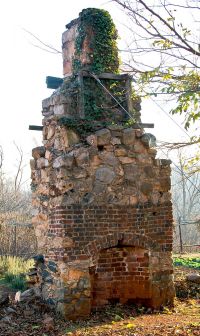Joiner's Shop
The foundation and chimney are all that remain of the Monticello joiner's shop, one of the first buildings to be constructed on Mulberry Row. A joiner was a woodworker who made doors, windows, and decorative finish work, such as cornices and mantels, balustrades, and railings.
In the forty-year course of the construction and reconstruction of the Monticello house, some of the finest architectural woodwork in Virginia was made in the Mulberry Row joiner's shop.
Thomas Jefferson employed highly skilled joiners to live and work at Monticello. Jefferson considered Irishmen James Dinsmore and John Neilson to be "house joiners of the very first order both in their knolege in Architecture, and their practical abilities."[1] Dinsmore and Neilson passed their skills on to enslaved men at Monticello, including John Hemmings, who overseer Edmund Bacon described as "a first rate workman—a very extra workman. He could make any thing that was wanted in woodwork."[2]
An inventory of tools that James Dinsmore made in 1809 reveals the specialized nature of the work in the Mulberry Row joiner's shop. Dinsmore listed over eighty planes for cutting a variety of moldings, each named for shapes they cut — astragal, ogee, ovolo, etc.[3]
Pine and poplar were the main woods used by Monticello's joiners for the architectural woodwork, which was then painted or, in the case of some of the doors, grained to look like mahogany. The parquet floor in the Parlor, the work of James Dinsmore, was made of cherry and beech. Most of the joiners were also skilled cabinetmakers, and numerous joiner's shop-made pieces of mahogany, cherry, and walnut furniture survive. John Hemmings was known to have made chairs, tables, desks, and the body of a landau carriage.
When referring to the joinery work of Monticello's free and enslaved craftsmen, Jefferson wrote that "there is nothing superior in the US."[4] After 1809, when the house was complete and the white workmen left, African-American artisans like John Hemmings trained young enslaved apprentices in the art of joining.
- Lucia Stanton, 1995
1809 Inventory
James Dinsmore’s List of Thomas Jefferson’s Tools, April 15, 1809
Memdm of Carpenters tools belonging to mr Jefferson—
15 pair hollows & rounds,. & 1 plane for making spouts
1 pair quarter rounds, 1 Do Snipe Bills
1 Do Side rabbitt planes—4 rabbitt planes & astragal
3 philasters. & one Spring plane—
4 pair Groveing planes & 1 Cut & thrust—
2 Plow planes & 9 plow bits
5 bead planes 9, ogees. & 2 quarter rounds—
2 Sash ovolos, 2 astragal Do—
1 Scotia & ovola & 1 ogee & ovola.
1 raising plane. 2 pair Base & surbase planes—
1 architrave Do.—11 Cornice planes of different kinds
3 Straight & 3 Circular Smoothing planes—1 toothing Do
4 Sets of Bench planes 5 in each Set—& 1 double Iron jointer—
3 try planes for Circular work, 3 Steel blade Squares—
1 bench vice 2 plated gages, 1 mortise Do—1 brace & 15 bits—
2 pair pincers & 1 pair cutting plyers—
2 Drawing knives 2 pair Compasses—
4 Sockett Chishels 4 mortise Do. & 13 former Do—
19 Gouges, 2 rasps 4 files,—15 Gimblets
3 pair hand screws, 3 iron Screws for pining up work
6 augres: 3 hand Saws 1 pannel Do 1 table Do 1 tenon Do—
1 Sash Do. 1 dove tail Do 1 frame Do & 2 lock Saws; 9 new plane irons
3 Saw files 1 axe 1 adz 1 bevel 1 miter Do 1 turkey Whet Stone &c &c
Jas Dinsmore
April 15th 1809
[verso:]
planes borrowed by Jas Dinsmore
1 Tuscan Cornice plane—
1 Sash astragal—
1 ogee & quarter round—
Bot—
1. Screw. do worth. 9/. by J Dinsmore £0–9
2 flooring. Do–worth 4/6 each by J Nelsen 0 9
Featured Blog Post: Archaeology on Mulberry Row—A Little History: Part 1
References
- ^ Jefferson to Benjamin Latrobe, May 11, 1815, in PTJ:RS, 8:479. Transcription available at Founders Online.
- ^ Hamilton W. Pierson, Jefferson at Monticello: The Private Life of Thomas Jefferson (New York: Charles Scribner, 1862), 109.
- ^ James Dinsmore’s List of Thomas Jefferson’s Tools, April 15, 1809, in PTJ:RS, 1:135-36. Transcription available at Founders Online.
- ^ Jefferson to Thomas Munroe, March 4, 1815, in PTJ:RS, 8:314. Transcription available at Founders Online.
